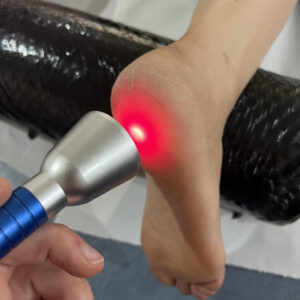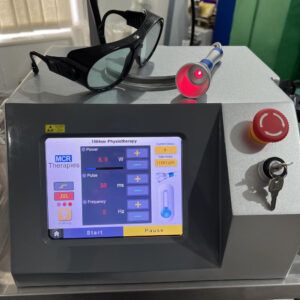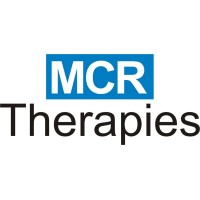Unleash the Healing Power of High-Intensity Laser Therapy for Optimal Health
In the dynamic landscape of contemporary medicine, it is essential to delve into innovative and alternative laser therapy techniques that provide safe, effective solutions for a variety of health challenges. Ongoing advancements in technology are revolutionizing treatment methods, prioritizing patient safety while maximizing therapeutic outcomes.
High-intensity laser therapy (HILT) is one such advanced option that has gained significant recognition for its broad applications in numerous therapeutic domains. This noninvasive approach proves to be highly effective in treating conditions like pain relief, rehabilitation from sports injuries, skin disorders, management of neurological conditions, and even certain dental treatments.
This comprehensive article seeks to delve deep into the scientific principles underpinning laser treatment, highlight its extensive benefits, and evaluate its transformative potential in modern healthcare practices. By harnessing the power of light to stimulate cellular processes and enhance recovery, this method—commonly known as photobiomodulation therapy—utilizes specific wavelengths emitted by lasers to achieve remarkable therapeutic results.
Explore the Numerous Benefits and Insights of High-Intensity Laser Therapy
- High-Intensity Laser Therapy serves as a holistic treatment modality suitable for a myriad of health issues, fostering overall wellness and recovery.
- Laser Therapy activates the body’s natural healing mechanisms, effectively reducing inflammation and facilitating a quicker recovery process.
- The advantages of Laser Therapy include significant pain reduction, faster healing times, and enhanced skin health.
- Laser Therapy often outperforms traditional treatment approaches by offering fewer side effects and improved patient satisfaction.

High-intensity laser therapy (HILT) signifies a revolutionary advancement in healthcare, presenting novel treatment options for patients confronting various medical challenges.
Its positive impacts on pain management, sports injury rehabilitation, treatment of skin conditions, and alleviation of neurological symptoms, along with its applications in dental care, suggest a future where HILT could become a standard, transformative therapeutic approach.
Lasers are categorized into different types based on their intensity, including high-intensity and low-level lasers. The science of laser therapy revolves around its ability to interact with cellular structures and penetrate various tissues, delivering targeted therapeutic effects.
The therapeutic benefits arise from biochemical processes initiated when cells absorb laser light. These processes enhance blood flow, reduce inflammation, accelerate tissue repair, and increase adenosine triphosphate (ATP) synthesis, a crucial component for cellular energy. One major advantage of high-intensity laser therapy is its proven effectiveness in alleviating pain.
The application of laser light promotes the release of endorphins—natural pain-relieving compounds that the body produces. This feature is particularly beneficial for individuals coping with chronic pain conditions such as fibromyalgia, arthritis, or ongoing back pain, as it can significantly diminish their discomfort.
Beyond pain relief, laser therapy is also highly effective in reducing inflammation. It can significantly alleviate swelling, redness, and discomfort associated with various conditions, including sprains, bursitis, and tendonitis, providing much-needed relief to patients.
Moreover, laser therapy enhances blood circulation in the treated areas, promoting the formation of new blood vessels which are essential for delivering nutrients and oxygen to cells. This improved circulation not only aids in tissue regeneration but also contributes to faster healing times, enabling patients to recover more quickly from injuries.
During the course of treatment, the stimulation of collagen production—an essential protein involved in tissue repair and wound healing—is initiated, making HILT a safe and noninvasive choice for individuals recovering from injuries, surgeries, or ulcers.
Unlike invasive surgical interventions or pharmacological treatments, HILT does not necessitate incisions or the use of medications, which provides reassurance and confidence to patients choosing this therapeutic option.
Laser therapy is recognized as a low-risk, painless treatment alternative that can be utilized independently or in combination with other therapeutic methods. It is vital to weigh the pros and cons of laser therapy against conventional medical treatments.
Traditional treatment approaches, such as medications and surgeries, have long been fundamental in patient care and have proven effective in various scenarios. However, these methods often come with associated risks and potential adverse effects.
For example, medications may lead to unwanted reactions, dependency issues, or long-term health implications. Surgical procedures can pose risks such as infections, scarring, and extended recovery periods. In contrast, laser treatments present a safe, noninvasive alternative that can yield results comparable to or even superior to traditional methods. High-intensity laser therapy is widely employed for effective pain management.
High-Intensity Laser Therapy has shown impressive success in alleviating both acute and chronic pain arising from various injuries. Conditions such as sciatica, neuropathy, and arthritis can experience substantial improvements with this powerful treatment strategy.
The natural endorphins released when the laser light targets the affected region can significantly diminish pain perception, offering much-needed relief for individuals grappling with chronic pain disorders.
 In sports medicine, laser therapy is a powerful tool for speeding up recovery times and enhancing treatment outcomes.
In sports medicine, laser therapy is a powerful tool for speeding up recovery times and enhancing treatment outcomes.
By directing laser light to injured areas, it alleviates pain, reduces inflammation, and promotes tissue healing. Consequently, athletes can return to their training regimens and competitive events more swiftly.
Additionally, laser therapy can serve as a preventive measure, lowering the risk of injuries and improving overall athletic performance. Numerous case studies have demonstrated the effectiveness of laser therapy in managing sports-related injuries.
Post-treatment, athletes suffering from sprains, strains, or tendonitis often report significant enhancements in pain levels, increased range of motion, and improved functional capabilities.
Skin conditions such as eczema, psoriasis, and acne can profoundly impact an individual’s quality of life and self-esteem. Laser therapy presents a promising solution for rejuvenating and restoring skin health. By directing laser light to affected areas, it reduces inflammation, accelerates cellular turnover, and boosts collagen production.
These effects can lead to improved skin texture, reduced redness, and diminished visibility of blemishes or scarring. Beyond cosmetic improvements, laser therapy can also effectively address serious skin issues, including skin cancer, vitiligo, and rosacea. This noninvasive and efficient approach provides patients with a pathway to reclaim their confidence and improve their skin’s health.
Neurological conditions like multiple sclerosis, neuropathy, and stroke can severely impact an individual’s quality of life.
Laser therapy has emerged as a potential treatment option for these complex disorders, offering various benefits to those affected. By targeting specific areas with laser light, it reduces inflammation, enhances cellular activity, and supports neuroregeneration.
For patients facing neurological challenges, the application of laser therapy can lead to improved nerve function, decreased pain levels, and an overall enhancement in their quality of life. Ongoing research continues to investigate the effectiveness of laser therapy in treating neurological conditions.
Studies indicate that individuals receiving laser treatments report improvements in motor functions, pain thresholds, and general well-being. However, further investigations are essential to fully understand the underlying mechanisms and optimize treatment protocols.
Maintaining oral health is crucial for overall wellness, and laser therapy has emerged as an effective tool in modern dentistry. This innovative technique can address a variety of dental challenges, including oral surgeries, tooth whitening, and managing periodontal disease.
By employing laser light on affected regions, it effectively eradicates harmful bacteria, reduces inflammation, and promotes tissue regeneration. This can lead to enhanced gum health, reduced bleeding, and improved oral hygiene.
The advantages of laser therapy extend into dental practices, offering precise and minimally invasive treatment options that can reduce postoperative discomfort, accelerate healing, and lessen the need for anesthesia.
Integrating laser therapy with traditional dental procedures can also significantly enhance their effectiveness. High-intensity laser treatment showcases remarkable potential across various medical fields.
 Its proven efficacy, safety profile, and noninvasive nature make it a valuable alternative to traditional treatment methods. Patients can benefit from a diverse range of laser treatment applications, including pain management, sports injuries, skin disorders, neurological issues, and dental care.
Its proven efficacy, safety profile, and noninvasive nature make it a valuable alternative to traditional treatment methods. Patients can benefit from a diverse range of laser treatment applications, including pain management, sports injuries, skin disorders, neurological issues, and dental care.
With continual advancements in this field, the future of high-intensity laser therapy looks exceptionally promising.
As technology progresses and our understanding of underlying mechanisms improves, laser therapy holds the potential to significantly reshape the healthcare landscape by offering safe and effective treatments for numerous conditions, thereby enhancing the quality of life for many individuals.
Nevertheless, further research is necessary to refine treatment protocols, explore new applications, and comprehend long-term effects to fully unlock the potential of high-intensity laser therapy.
With ongoing advancements in this area, laser therapy is positioned to revolutionize healthcare and establish itself as a standard treatment option.
For an in-depth exploration of this topic, click Laser Therapy for Pain Management.
Frequently Asked Questions About High-Intensity Laser Therapy
Understanding High-Intensity Laser Therapy: What Is It?
High-Intensity Laser Treatment (HILT) is an advanced, noninvasive medical approach that utilizes high-powered lasers to activate healing processes and alleviate pain in damaged tissues.
The Mechanisms Behind High-Intensity Laser Treatment: A Detailed Examination
HILT directs concentrated laser energy straight to the affected area, stimulating the body’s natural healing processes. This laser energy penetrates deeply into tissues, improving blood flow and oxygen delivery, reducing inflammation, and supporting tissue recovery.
A Comprehensive Look at Conditions Treated by High-Intensity Laser Therapy
HILT is versatile and can effectively manage a wide range of conditions, including musculoskeletal injuries, chronic pain syndromes, arthritis, neuropathy, and various sports-related injuries.
Assessing the Safety of High-Intensity Laser Treatment: Is It a Reliable Option?
Yes, HILT is considered a safe and noninvasive treatment alternative. The laser energy used in HILT is carefully regulated and monitored to ensure patient safety and prevent any harm.
Unlocking the Advantages of High-Intensity Laser Therapy: What Can You Anticipate?
The benefits of HILT include reduced pain and inflammation, enhanced range of motion, accelerated healing processes, and a decreased dependence on medication for pain relief.
What to Expect Regarding the Duration of High-Intensity Laser Treatment Sessions
The length of a HILT session can vary based on the specific condition being treated and the severity of the injury. Typically, each session lasts between 10 to 30 minutes.
How to Determine the Number of High-Intensity Laser Therapy Sessions Required
The number of HILT sessions needed will depend on the individual patient’s circumstances and the condition being treated. While some patients may experience improvements after a single session, others might require a series of treatments over several weeks or months.
The Article Laser Therapy: An Effective High-Intensity Treatment Option appeared first on https://mcrtherapies.com
The Article Laser Therapy: An Effective Treatment with High Intensity Was Found On https://limitsofstrategy.com


It’s fascinating to think that lasers, often associated with sci-fi movies and fancy light shows, are now stepping in as the superheroes of modern medicine! I mean, who knew we could harness their powers to help with everything from stubborn sports injuries to skin disorders? It’s like giving your body a sci-fi makeover without the side effects of an alien encounter.
Your exploration of high-intensity laser therapy (HILT) truly highlights a pivotal shift in how we approach healing in modern medicine. As someone who has witnessed its benefits firsthand—especially in the realm of sports injuries—I can attest to the remarkable efficacy of this technology.
Your experience really illustrates the transformative potential of high-intensity laser therapy. It’s fascinating how technology like this is reshaping our understanding of healing, particularly in sports medicine. The ability of HILT to reduce inflammation and promote tissue repair can significantly enhance recovery times, not just for athletes but for anyone coping with injury.
It’s cool to hear you’ve experienced the benefits of high-intensity laser therapy firsthand, especially with sports injuries. It’s impressive how this tech is changing the game.